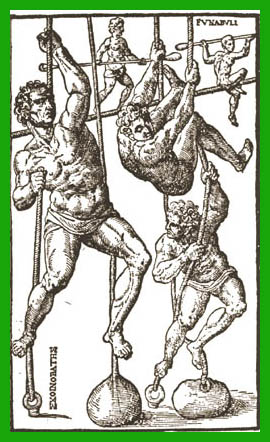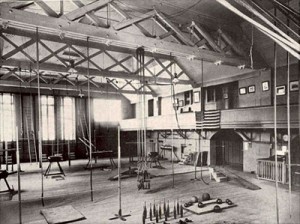If you happened to be around Long Beach CA on August 25-28th you probably saw a noticeable number of people wearing really short shorts and tank tops. Then you might have noticed others wearing fairly normal clothes but who probably looked stronger than your average bear. Both groups were in town for the annual Perform Better Summit, the last of the year and undoubtedly the best fitness education event on the West Coast. But one group probably picked up more information while the others may have been there to “workout smarter” and show off their deltards 😉
It’s hard to put into words how beneficial events such as Perform Better have been to building my knowledge base, and thus resulted in healthier, slimmer clients. Chris Poirer and Co. really deserve a lot of credit for all their hard work and vision. Without them I shudder to think how bad training would be at more gyms.
Since getting back to Portland I have just begun reviewing the many pages of notes I took, but hey gimme a break! The weather in Portland has been extremely great, and with cyclocross season rapidly coming up I’m trying to squeeze some training into my days running EFL. Regardless, some things I learned are already being implemented into our member’s training.
Having been to PB for 5 or so years in a row it’s interesting to note the trends and changes over time in what the biggest names in the industry speak on. This past two years it seems that some large themes of movement quality/tissue quality/corrective work ran through many talks, and even creeped into some talks that were supposed to be about sport performance or business. This year my favorite talks/hands-on workshops were those by the most experienced, and humble, speakers.
John Brookfield, inventor of battling ropes and other methods of constant velocity training, and his amazingly strong assistant Ingrid Marcum were doing movements with the ropes that 25 year old tatted up trainers failed at. Not only was it quite entertaining so witness, but listening to John explain the principles behind his training was fascinating.
Clue: Working fundamental movement patterns up to a very high level.

They had it right back in 1569
Dan John, a perennial favorite spoke about the four quadrants of lifting which comes down to mastering the training qualities that are most appropriate. And in most people’s case that means working fundamental movement patterns (there are those words again) to build a solid base of movement quality, then putting strength on top of that.
Dan’s quote of the weekend: “The Goal is to keep the goal the goal”
One could chew on that for awhile.
Dr. Sue Falsone, Gray Cook, Dr. Greg Rose, and Dr. Lee Burton all spoke on various aspects of joint mobility, stability, and… wait for it… building a base of movement quality above all else.
But aside from hanging out with dear friends, colleagues, and fitness super couples Roland and Galya Denzel, and Peter Parsiliti and Shabnam Islam the highlight was spending as much time as possible watching and talking with Dr. Ed Thomas.
Dr. Thomas has probably forgotten more about fitness than most of us will ever know. And I don’t think I’ve ever met anyone as humble as is knowledgable. Right before a panel discussion with all the featured speakers Dr. Thomas mentioned that he’d rather sit and listen than participate – which is saying something since he has been involved in fitness before some of the other speakers were even born!
Always learning.
He is credited with reintroducing the public to Indian club swinging, with is not only a great method of developing shoulder and scapular mobility, but also for restoring and improving…. yep, fundamental movement patterns and movement quality. And Dr. Thomas moves better than most 20 year olds due to his lifelong passion for continuing to train and pass along the many years of cumulative knowledge his teachers imparted to him as a young man training at a German Turner training hall in Iowa.
In conversation with Dr. Thomas he related talks he’s had with masters of other movement disciplines regarding methods of instructing principles that seem to cross many cultures and eras. Once such discussion he had with Filipino martial arts master Dan Inosanto concerned the importance of circular patterns common throughout many martial art systems around the world but also in health systems such as Indian club swinging. It’s only the application that differs, similar to the way in which martial art students used to be taught methods of bone setting and other healing procedures.
So while the topic of “functional” movement, for lack of a better term is nothing new, and most would agree that the fitness industry took a wrong step when gyms began to be designed around expensive machines for marketing purposes rather than what works best, the issue of movement quality vs. difficult exercises seems to be arising.
We’ve all seen videos of people doing impressive looking exercises on youtube or fitness forums, but should that mentality of “go heavier go bigger” really be encouraged? Dr. Thomas and some others appear to be heading more in the direction of attaining the highest movement quality possible using the aforementioned movements (hinging, pulling, pushing, climbing, rotation etc…). Though not initially impressive to we who are brought up valuing instant gratification and spectacles, these really smart people are on to something that the wiser practitioners always figure out.
Bruce Lee’s famous quote that martial art students should avoid “flowery” techniques that look good, and instead focus on efficiency and simplicity come to mind. The best athletes are always those that have mastered the fundamentals and move with extreme efficiency.
What Dr. Thomas now does at his job with the Iowa Department of Education is bringing back methods of teaching fundamental physical skills to kids. Previous to this position he worked with the U.S. Army at Fort Benning doing much of the same thing, only with more martial applications.
Here is a video showing some of the training tools and methods Dr. Thomas is using that have been proven for decades, if not centuries, to improve many aspects of health and fitness. Ropes, indian clubs, kettlebells, dumbbells, medicine balls, monkey bars and so on.
Dr. Ed Thomas and physical education program in Iowa.
I’ve certainly found as I’ve progressed in experience that these simple tools really pay off in helping get people to move better, with makes them feel better and want to move more, which lo and behold leads to weight loss. Simple, but not easy.
Share
SEP


About the Author:
Owner of Elemental Fitness Lab in Portland, OR. Our approach to training is to integrate research (I'm an NSCA CSCS, certified Functional Movement Screen, and Precision Nutrition) with practical experience. I've studied martial arts in Japan and the U.S. for many years, and have put in my time in the gym, in the water, on the snow, on the rock wall, and on the bike.